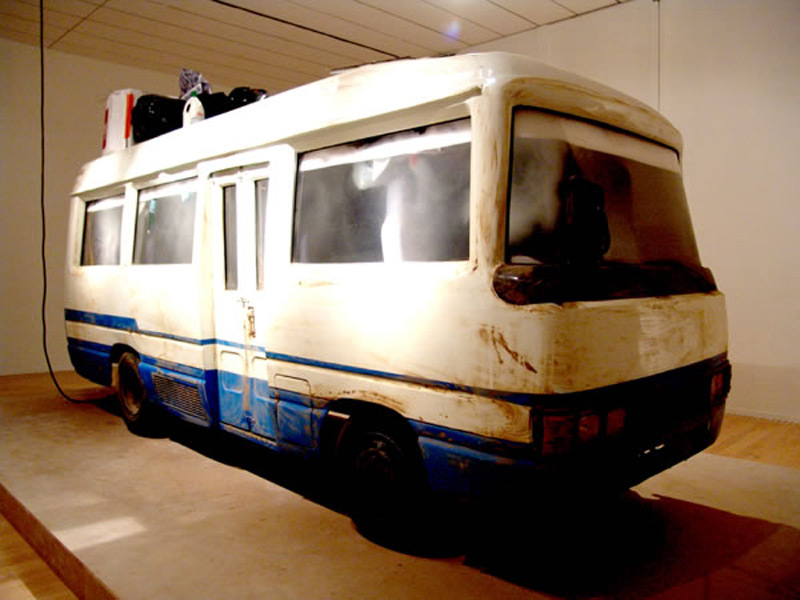Exclusive Q & A with DSL Collection
Here is a Shanghai Eye web exclusive-
A short Q&A with the owners of the DSL Collection, one of the leading collections of Chinese contemporary art.
Shanghaieye (SHE): Could you outline your collection- what significant works does it contain, what is the representative them of the collection, and what is your ultimate aim for the collection- to produce a museum or book, to sell at auction..or?
DSL: We began to collect three years ago so unfortunately it was very difficult to have access to works from the 80’s.
What are the main ideas which direct the building of this collection?
First we have adopted to build this collection what I shall call a “Chinese approach”. In other words we try to put aside all our cultural perceptions and use Chinese cultural specificities. That is why we rely on Chinese artists and curators to help us.
The second point is that the collection has to be focused on experimental and avant-garde works. Consequently a big part of the collection consists of installations and videos.
The third point is that the collection has to reflect all the different regional art scenes like Beijing, Shanghai, Guangzhou, and also overseas Chinese artists.
Today, in the collection there are more than 70 artists represented.
DSL Collection is not only a collection. It is a project which focuses on :
- Building the collection
- Communicating. Today with the internet and websites like Youtube, blogs, forums, sharing has become very important. Art is, by nature, made to be public. With the Internet, art can be dematerialized and thus create a new kind of experience, which is complimentary and never replaces the physical experience of an artwork. Internet is also a powerful tool to reach instantly people all over the world. This website, which is in Chinese and English has many interactive features, particularly a virtual museum.
We try to give big visibility to the website. We have two people working full time to spread the link on blogs and forums in China and elsewhere. We have decided also to work with a Chinese PR agency, Lime’s angels.
- Being a center of reflection. From the beginning we have put special attention on the contents, which is done with the help of artists and curators. Today we are also acquiring contents—for instance all the archives of Visual Production magazine– and also forming strategic partnerships with websites in order to achieve this goal, such as “we need money not art”. Known as “wnmna”, it is the most well known platform on multi-media Chinese art.
We are working on an e-book which will be very innovative in terms of presenting a collection.
Why an e-book? An e-book will never replace a book but can bring a different experience. It has advantages in terms of tools that you can use to create it, such as images, sound, video, 3d animation. Also it can be distributed in very large numbers, either by CD or downloads. As the collection changes, with an e-book, it is very easy to update. We do not want to produce a museum in a specific place because it is very reductive in a sense. We are working on the concept of the nomad collection which could travel from one city to another.
Sell at auction? I have nothing against auctions. Today they are very important in the art world. To cope with the principle of a limited collection means selling some works. When we decide to sell, we first go back to the gallery which sold it to us and, in 90% of these cases, we find a way through the gallery to sell it. That is the best way, we think, to establish long term relations with artists and galleries
SHE: Why have you decided to collect Chinese contemporary art, and do any other art regions/non-Chinese artists appeal to you, or are you specifically wanting to create a Chinese-only collection?
DSL: For a long time before we were collecting contemporary design very seriously. Thus we were able to gather one of the most important design collections in Europe with works by Ron Arad, Marc Newson, Bouroullec , and many Italian deisgners….After our first trip to China we decided…….to collect Chinese art and to concentrate only on it.
Why? For a single reason: if I have to characterize China today I would describe it as outscale, energy, creativity.
We believe that art is one of the mirrors of society and one can find that in the Chinese art scene. We want focus on Chinese contemporary art in order to go in depth.
SHE: What critical trends do you see as significant, and what critics/curators (if any) do you admire and appreciate?
DSL: What one should not forget is it is a private collection. I do not claim to be an art historian. Rather, this is a personal adventure which has not the pretension to replace public institutions.
As for me what is interesting in Chinese art is:
First, it is new in the sense that we can put the starting point in the eighties, so collecting Chinese art is like collecting a piece of history.
Second, the art has reflected the evolution of Chinese society. In the beginning, artists focused on a political discourse. Then, from 1995 on, social questions like urbanization, sexual identity, and many social problems emerged. Chinese society is experiencing a big bang with good and bad consequences, but what is sure is that the energy created by this situation is reflected in its art.
Third, China is a big and very diverse country. What happened and is happening in Beijing is not the same as in Shanghai or Guangzhou. I have great respect for many curators and without their help nothing could have been done. I am very close to Martina Jiechang Koppel, David Chan and Zhang Wei but this list is not exhaustive.
SHE: As the price of Chinese contemporary art is spiraling rapidly are there any works you didn’t purchase you wish you had now?
DSL: Clearly, yes. I would have loved to have in the collection important works of Xiaogang, Liu Xiaodong, Yue Mingjun, and some others, but I cannot afford it, and I am not interested in second rate works by these artists.
SHE: As the Chinese arts scene is very fluid and rapidly changing how do you keep track of it, and do you explore other regions of China besides the main centers (ie besides Beijing and Shanghai)?
DSL: We go to China every two months because my brother in law lives in Shanghai. My son and my daughter also speak Chinese so they often come with us. We have already visited Shenzhen and Guangzhou.
SHE: Do you feel you can collect certain works that would not be able to be shown in mainland China, or do you feel this is a non-issue?
It is not an issue but clearly in the collection there are works that at the present moment cannot be shown. It is not a problem for me. I respect the Chinese sensibility. I will just wait and see in the future. If the work is important one day it will inevitably be shown everywhere.
SHE: Given the current political situation between France and China, with growing tit-for-tat diplomatic disputes, do you feel this has had any effect on your collection activities?
DSL: Not at all.
Labels: DSL Collection, Shanghai Eye









0 Comments:
Post a Comment
Subscribe to Post Comments [Atom]
<< Home